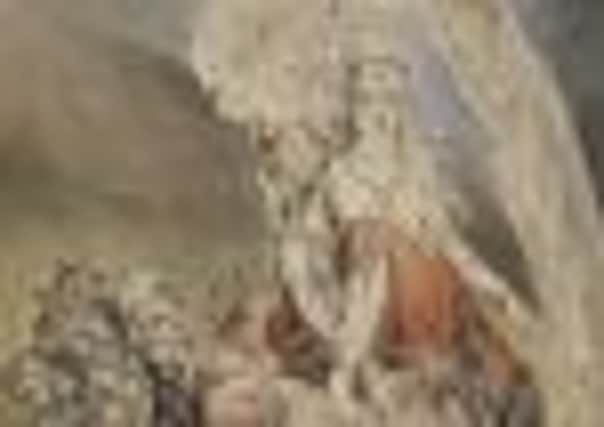Casting a spell on the art world: The exhibition that explores the weird world of witches


It’s not merely the unsettling chills being whipped up across the city by the Beast from the East however, but something altogether darker. Something wicked this way comes.
Next year the Scottish National Gallery of Modern Art will open its doors on a unique collection of works exploring the wyrd world of witches, and shedding a fascinating light on their legend.
Advertisement
Hide AdAdvertisement
Hide AdEdinburgh and the Lothians has a long history with the dark arts of witchcraft of course, from Hagg’s Knowe on the slopes of Arthur’s Seat where illicit covens are said to have woven their spells, to the infamous North Berwick witch trials of 1590, which saw 70 women confess under torture to meeting the devil.
The fascination we hold with the world of sorcery has led to countless works of art and literature, and today witches surround us, from the fairy tales we hear as children to characters such as Hermione Granger and TV shows such as Game of Thrones.
So it is perhaps not too surprising to discover that the Scottish National Gallery was chosen in part thanks to its large collection of works which relate to the practice. It was this which brought artist and writer Deanna Petherbridge to Scotland to start putting together Witches and Wicked Bodies, which will open in the city next summer.
In seeking to delve as deeply as possible into how our vision of witches has evolved through the centuries the curators have also gathered together major works on loan from the British Museum, the National Gallery in London, the Tate and the Victoria & Albert Museum.
Advertisement
Hide AdAdvertisement
Hide AdThe result not only includes an extremely rare chance to see two of William Blake’s most stunning drawings – The Whore of Babylon being shown alongside the National Galleries’ own Blake drawing, once thought to depict Hecate, the witch of the crossroad – but an opportunity to see some of the earliest depictions of practices which have become essential elements of folklore.
Co-curator Patricia Allerston said: “The Blake drawings are very fragile so they are generally kept off display, which means this will be a rare chance to see these two drawings together.
“It’s a very unique exhibition in that its the first time we’ve done one on a single subject, rather than an artist, and it’s one which I’m sure people will find fascinating, given the local history as well.”
The witch trials in North Berwick and those that followed over 16 months between 1661 and 1662 – starting in East and Midlothian and eventually seeing 660 Scots accused of sorcery and devil worship, with many tortured and killed – were sadly far from isolated incidents.
Advertisement
Hide AdAdvertisement
Hide AdAcross Europe there is a long history of the persecution of witches, particularly widespread in the 16th and 17th centuries, accounting for thousands of deaths of women and even children. Prints and drawings dating from this period will form a key part of the exhibition, showing how the advent of the printing press gave artists and writers the means to share the ideas, myths and fears about witches which underpin our ideas about witchcraft to this day.
The exhibition will focus on six key themes. The centrepiece of Witches Sabbaths and Devilish Rituals is one of the most famous images of witches of all time – Salvator Rosa’s Witches at their Incantations.
For many people the Unnatural Acts of Flying exhibition will prove the most interesting, showing the evolution of the image of the witch as an old woman riding a broomstick, and revealing than far from the cloaked figure wearing a pointy hat, earlier depictions were more sinister.
Elsewhere the exhibition has plenty on offer, from Magic Circles, Incantations and Raising the Dead, which will allow visitors to see witches cooking up spells as in Frans Francken’s 1606 painting Witches’ Sabbath, to Hideous Hags and Beautiful Witches, including the medusa-like witch with snakes for hair in John Hamilton Mortimer’s Envy and Distraction. This section will also feature unsettling works depicting old crones by Francisco de Goya – the exhibition contains a significant group of works by the Spanish artist.
Advertisement
Hide AdAdvertisement
Hide AdWorks depicting the various appearances of the witches in Shakespeare’s Macbeth, in Unholy Trinities and The Weird Sisters from Macbeth, will range from John Martin’s theatrical large-scale painting of Banquo and Macbeth lost on the blasted heath, to John Runciman’s striking drawing of the Three Witches conspiring over Macbeth’s fate.
The exhibition is brought right up to date with The Persistence of Witches, featuring works by contemporary artists Kiki Smith and Paula Rego and looking at both the expressions and attitudes of the “witch” and the famous Pendle Witch trials in 1612 in Lancaster.
John Leighton, director general of the National Galleries of Scotland, said: “ I believe that this is the first time that witchcraft across the ages has been the subject of a major art exhibition in the UK and we are delighted to be partners with the British Museum on this truly fascinating and compelling show.“
n Witches and Wicked Bodies is to be held at the Scottish National Gallery of Modern Art (Modern Two) from July 27 to November 3, 2013.